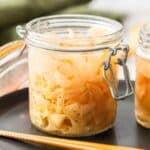
Easy Pickled Ginger (Gari)
This easy recipe for Pickled Ginger (Gari) is so delicious, with a wonderful flavour and warmth. To make it, we soak thin slices of young ginger in a sweet rice wine vinegar brine. As they soak, they become a very soft, natural shade of pink. Serve thin slices of this pickle alongside sushi, sashimi and so much more.
Servings 1 250 ml (8.5 fluid oz) Jar
Calories 375kcal
Ingredients
For the Ginger:
- 200 g (7 oz) fresh young ginger See Note 1
- 2 teaspoon cooking sea salt See Note 2
- boiling water - to cover the ginger
Pickling Liquid:
- ¼ cup (60 g) caster/superfine sugar
- ½ cup (120 ml) rice vinegar/rice wine vinegar See Note 3
- ¼ cup (60 ml) water See Note 4
Instructions
To Sterilise the Jar:
- Sterilise the jar you'll be using to store the ginger.Choose glass jars with an airtight, metal lid and ensure they have been washed by hand in hot soapy water then rinsed well. Check that the metal lids do not have rubber inserts - if they do allow them to air dry. Preheat the oven to 130 Degrees C (270 F) and place the jar in the oven for 15-20 minutes. Keep the jar warm.
For the Pickled Ginger:
- Using a teaspoon, scrape the skin off the ginger.Remove any brown spots or blemishes that may be left.
- Using a vegetable peeler, sharp knife or mandoline on a super-thin setting, slice pieces of ginger.In a small heat-proof bowl, add the slice ginger and sprinkle the salt over the top. Stir and allow to sit for 5 minutes.
- Pour boiling water on the ginger (just enough to cover) and sit for a further 2 minutes.Drain the water, and once cool enough to handle, use your hands to squeeze any excess liquid from the ginger.Set the ginger aside to drain further on paper towel while you prepare the pickling liquid.
- Prepare your pickling liquid by placing the water, rice wine vinegar and sugar in a non-reactive saucepan. (See Note 5)On a medium heat, stir to dissolve the sugar. Increase heat, and boil for 30 seconds.
- Place the ginger pieces into the sterilised jars before carefully pouring the hot pickling liquid over the ginger.Seal the jar, and allow to cool on your kitchen bench for 30 minutes, before placing in the refrigerator.
- The Pickled Ginger can be eaten once cooled, but I recommend waiting at least 24 hours to allow the flavours to develop and mellow.
Notes
- Ginger: use the freshest, youngest ginger you can find. The older the ginger, the more fibrous. Fresh ginger has a more delicate skin and milder flavour. Older ginger can be used, but extra care needs to be taken when being prepared.
- Salt: I use a cooking sea salt (not flakes.) Regular table salt may contain anti-caking agents, is much stronger and not suitable for this recipe.
- Vinegar: rice vinegar/rice wine vinegar is preferable for this recipe. Some readers have substituted apple cider vinegar.
- Water: it is essential to use filtered/un-chlorinated water when pickling or preserving.
- Non-reactive saucepans: are those which are made from stainless steel, glass, ceramic or enamelled cookware. Aluminium, copper and iron pans are reactive. Acidic foods, such as vinegar, should be heated in a non-reactive saucepan to avoid taking on a metallic taste.
- The colour: when covered with the pickling liquid, slices of young ginger will turn a delicate, pale pink shade. It will look much less vibrant than commercially prepared Pickled Ginger, that is often altered either naturally or artificially. The pale pink hue achieved with young ginger in this recipe is ideal.
- Storage: when prepared and stored correctly in a sterilised jar, the ginger will last in the fridge for 6 months.
- Nutritional information: is based on the entire jar, and includes the pickling brine.
Nutrition
Calories: 375kcal | Carbohydrates: 85g | Protein: 4g | Fat: 2g | Saturated Fat: 0.4g | Polyunsaturated Fat: 0.3g | Monounsaturated Fat: 0.3g | Sodium: 4683mg | Potassium: 835mg | Fiber: 4g | Sugar: 53g | Calcium: 45mg | Iron: 1mg